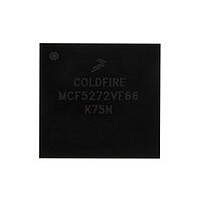MCF5272VF66 Freescale, MCF5272VF66 Datasheet - Page 443

MCF5272VF66
Manufacturer Part Number
MCF5272VF66
Description
Manufacturer
Freescale
Datasheet
1.MCF5272VF66.pdf
(544 pages)
Specifications of MCF5272VF66
Family Name
MCF5xxx
Device Core
ColdFire
Device Core Size
32b
Frequency (max)
66MHz
Instruction Set Architecture
RISC
Supply Voltage 1 (typ)
3.3V
Operating Temp Range
0C to 70C
Operating Temperature Classification
Commercial
Mounting
Surface Mount
Pin Count
196
Package Type
MA-BGA
Lead Free Status / RoHS Status
Not Compliant
Available stocks
Company
Part Number
Manufacturer
Quantity
Price
Company:
Part Number:
MCF5272VF66
Manufacturer:
HYNIX
Quantity:
19
Company:
Part Number:
MCF5272VF66
Manufacturer:
FREESCAL
Quantity:
885
Company:
Part Number:
MCF5272VF66
Manufacturer:
Freescale Semiconductor
Quantity:
10 000
Part Number:
MCF5272VF66
Manufacturer:
FREESCALE
Quantity:
20 000
Company:
Part Number:
MCF5272VF66J
Manufacturer:
Freescale
Quantity:
256
Company:
Part Number:
MCF5272VF66J
Manufacturer:
Freescale Semiconductor
Quantity:
10 000
Company:
Part Number:
MCF5272VF66R2
Manufacturer:
Freescale Semiconductor
Quantity:
10 000
Company:
Part Number:
MCF5272VF66R2J
Manufacturer:
Freescale Semiconductor
Quantity:
10 000
- Current page: 443 of 544
- Download datasheet (7Mb)
Signal Descriptions
GCI mode: GDCL1_OUT is used to clock data in and out of DIN1 and DOUT1 for GCI port 1. DCL1 is
twice the bit rate; that is, two clocks per data bit.
When this pin is configured as an output, the GDCL1_OUT clock signal from the on-chip synthesizer
clock generator is output on this pin. Also GDCL1_OUT is used to internally drive all ports and delayed
sync generators associated with ports 1, 2, and 3.
19.16.2.2 GCI/IDL Data Out (DOUT1)
IDL mode: The DOUT1 output is for clocking data out of IDL port 1. Data is clocked out of DOUT1 on
the rising edge of DCL1. DOUT1 is also used for clocking data from ports 2 and 3.
GCI mode: The DOUT1 output is for clocking data out of GCI port 1. DCL1 is twice the bit rate, that is,
two clocks per data bit.
19.16.2.3 GCI/IDL Data In (DIN1)
IDL mode: The DIN1 input is for clocking data into IDL port 1. Data is clocked into DIN1 on the falling
edge of DCL1. DIN1 is also used for clocking data into ports 2 and 3.
GCI mode: The DIN1 input is for clocking data into GCI port 1. DCL1 is twice the bit rate, that is, two
clocks per data bit. DIN1 is also used for clocking data into ports 2 and 3.
19.16.2.4 GCI/IDL Frame Sync (FSC1/FSR1/DFSC1)
IDL mode: FSR1 is an input for the 8-KHz frame sync for port 1.
GCI mode: FSC1 is an input for the 8-KHz frame sync for port 1. Normally the GCI FSC signal is two
clocks wide and is aligned with the first B channel bit of the GCI frame. Many U-interface devices
including the MC145572 and MC145576 change the width of FSC to one clock every 12 mS, indicating
a U-interface super frame boundary. The MCF5272 can accept either frame sync width.
When this pin is configured as an output, the DFSC1 sync signal from the on-chip clock synthesizer is
output on this pin. Also DFSC1 is used to internally drive the port 1 frame sync and the delayed sync
generators associated with ports 2 and 3. The width of DFSC1 can be configured for 1, 2, 8, or 16 DCL
clocks duration. The location of DFSC1 is programmable in single clock increments up to a maximum
count of 0x3FF.
19.16.2.5 D-Channel Request (DREQ1/PA14)
IDL mode: This pin can be configured as the DREQ1 output in IDL mode for signalling to a layer 1 S/T
transceiver that a frame of data is ready to be sent on the port 1 D channel.
Port A mode: I/O pin PA14.
19.16.2.6 D-Channel Grant (DGNT1_INT6/PA15_INT6)
This pin can be independently configured as the input, DGNT1, used by a Layer one ISDN S/T transceiver
to indicate that D-channel access has been granted.
®
MCF5272 ColdFire
Integrated Microprocessor User’s Manual, Rev. 3
Freescale Semiconductor
19-33
Related parts for MCF5272VF66
Image
Part Number
Description
Manufacturer
Datasheet
Request
R
Part Number:
Description:
Mcf5272 Coldfire Integrated Microprocessor User
Manufacturer:
Freescale Semiconductor, Inc
Datasheet:

Part Number:
Description:
MCF5272 Interrupt Service Routine for the Physical Layer Interface Controller
Manufacturer:
Freescale Semiconductor / Motorola
Datasheet:

Part Number:
Description:
TOWER ELEVATOR BOARDS HARDWARE
Manufacturer:
Freescale Semiconductor
Datasheet:

Part Number:
Description:
TOWER SERIAL I/O HARDWARE
Manufacturer:
Freescale Semiconductor
Datasheet:

Part Number:
Description:
LCD MODULE FOR TWR SYSTEM
Manufacturer:
Freescale Semiconductor
Datasheet:

Part Number:
Description:
DAUGHTER LCD WVGA I.MX51
Manufacturer:
Freescale Semiconductor
Datasheet:

Part Number:
Description:
TOWER SYSTEM BOARD MPC5125
Manufacturer:
Freescale Semiconductor
Datasheet:

Part Number:
Description:
KIT EVALUATION I.MX51
Manufacturer:
Freescale Semiconductor
Datasheet:

Part Number:
Description:
KIT DEVELOPMENT WINCE IMX25
Manufacturer:
Freescale Semiconductor
Datasheet:

Part Number:
Description:
TOWER SYSTEM KIT MPC5125
Manufacturer:
Freescale Semiconductor
Datasheet:

Part Number:
Description:
TOWER SYSTEM BOARD K40X256
Manufacturer:
Freescale Semiconductor
Datasheet:

Part Number:
Description:
TOWER SYSTEM KIT K40X256
Manufacturer:
Freescale Semiconductor
Datasheet:

Part Number:
Description:
Microcontrollers (MCU) MX28 PLATFORM DEV KIT
Manufacturer:
Freescale Semiconductor
Datasheet:

Part Number:
Description:
MCU, MPU & DSP Development Tools IAR KickStart Kit for Kinetis K60
Manufacturer:
Freescale Semiconductor
Datasheet:

Part Number:
Description:
24BIT HDMI MX535/08
Manufacturer:
Freescale Semiconductor
Datasheet:











